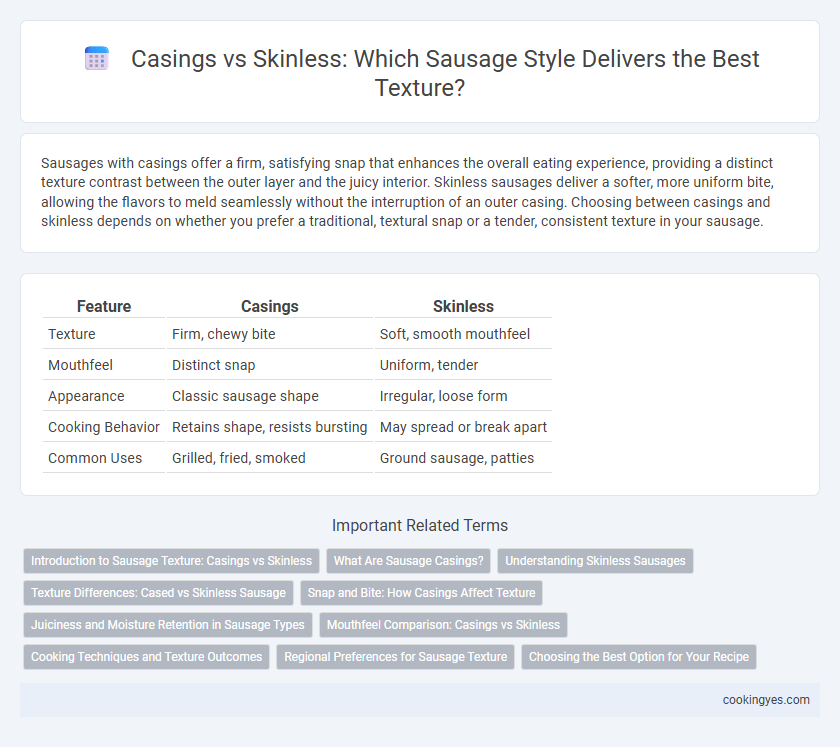Sausages with casings offer a firm, satisfying snap that enhances the overall eating experience, providing a distinct texture contrast between the outer layer and the juicy interior. Skinless sausages deliver a softer, more uniform bite, allowing the flavors to meld seamlessly without the interruption of an outer casing. Choosing between casings and skinless depends on whether you prefer a traditional, textural snap or a tender, consistent texture in your sausage.
Table of Comparison
| Feature | Casings | Skinless |
|---|---|---|
| Texture | Firm, chewy bite | Soft, smooth mouthfeel |
| Mouthfeel | Distinct snap | Uniform, tender |
| Appearance | Classic sausage shape | Irregular, loose form |
| Cooking Behavior | Retains shape, resists bursting | May spread or break apart |
| Common Uses | Grilled, fried, smoked | Ground sausage, patties |
Introduction to Sausage Texture: Casings vs Skinless
Sausage texture is significantly influenced by the choice between casings and skinless varieties, with casings offering a firm, bite-friendly exterior that helps retain juices and shape during cooking. Skinless sausages provide a softer, more uniform texture, making them easier to bite through but less resistant to cooking stress. The selection directly affects mouthfeel, cooking performance, and overall sensory experience of the sausage.
What Are Sausage Casings?
Sausage casings are natural or synthetic tubes that encase ground meat and spices, providing structure and shape during cooking. Natural casings, typically made from animal intestines, offer a traditional snap and chewiness, enhancing the texture and flavor profile of sausages. Skinless sausages omit these casings, resulting in a softer, less textured bite, often preferred for easier slicing and quicker cooking.
Understanding Skinless Sausages
Skinless sausages offer a softer, more tender texture compared to traditional casings, as they lack the natural or synthetic outer layer that provides a firm snap. Without casings, these sausages cook more evenly and quickly, resulting in a smoother bite ideal for recipes requiring a delicate mouthfeel. Understanding skinless sausage production involves recognizing techniques like direct filling into molds or casings removal post-cooking, emphasizing their convenience and versatility in culinary applications.
Texture Differences: Cased vs Skinless Sausage
Cased sausages offer a distinct snap and firmer bite due to the natural or synthetic casing that holds the meat tightly together, creating a textured contrast with the juicy interior. Skinless sausages, lacking an outer casing, provide a softer, more tender texture that is easier to bite through and melt-in-the-mouth, often preferred for smoother recipes. The choice between cased and skinless sausage significantly impacts the eating experience, balancing chewiness and succulence based on casing presence.
Snap and Bite: How Casings Affect Texture
Sausage casings create a distinctive snap and firm bite that skinless sausages lack, enhancing the overall eating experience by providing a satisfying contrast to the tender meat inside. Natural casings, typically made from animal intestines, offer a unique elasticity that replicates traditional sausage textures, while synthetic casings can vary in firmness and mouthfeel. Skinless sausages, with their uniform texture, prioritize ease of chewing but miss the characteristic snap that defines many classic sausage varieties.
Juiciness and Moisture Retention in Sausage Types
Natural casings provide superior juiciness and moisture retention in sausages due to their porous structure, which allows the sausage to breathe and maintain optimal hydration during cooking. Skinless sausages often lack this moisture barrier, resulting in a drier texture and less juiciness. The choice between casings and skinless varieties significantly impacts the mouthfeel and overall succulence of the final product.
Mouthfeel Comparison: Casings vs Skinless
Sausage casings provide a firm, snap-like mouthfeel that enhances the overall eating experience by creating a satisfying contrast between the exterior and the juicy interior. Skinless sausages offer a softer, more uniform texture, resulting in a smoother bite without the distinctive snap. Choosing between casings and skinless depends on desired texture preferences, with casings favored for traditional snappiness and skinless preferred for tenderness.
Cooking Techniques and Texture Outcomes
Sausage casings provide structure that enhances firmness and aids even cooking, creating a satisfying snap when bitten, while skinless sausages rely on bindings and are softer, often resulting in a creamier texture. Cooking casings over direct heat helps crisp the exterior without compromising juiciness, whereas skinless sausages require gentler methods like pan-frying or poaching to prevent crumbling. The choice between casings and skinless impacts moisture retention and mouthfeel, with casings locking in flavors and skinless variants offering a delicate, tender bite.
Regional Preferences for Sausage Texture
Natural casings create a firmer, snap-like texture preferred in traditional European sausages, enhancing the eating experience with a slightly chewy bite. Skinless sausages, common in American and Australian markets, offer a softer texture that appeals to those favoring ease of consumption and juiciness. Regional preferences in sausage texture often reflect local culinary traditions and consumer habits, influencing the choice between casings and skinless varieties.
Choosing the Best Option for Your Recipe
Sausage casings provide a firm, resilient texture that helps retain juiciness and enhances the overall mouthfeel, making them ideal for recipes requiring a traditional snap. Skinless sausages offer a softer, more delicate bite, suitable for dishes where a tender texture is preferred or casing removal is desired. Selecting between casings and skinless depends on the desired texture outcome and cooking method, with natural or synthetic casings favored for grilling and smoking, while skinless varieties excel in recipes like casseroles or stews.
Casings vs Skinless for sausage texture Infographic

 cookingyes.com
cookingyes.com